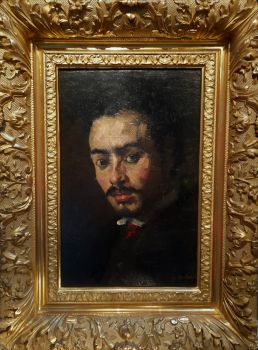TEFAF: Thirty Years of Excellence
It’s time for the annual ‘rendez-vous’ for all true art lovers in the world. TEFAF Maastricht is generally considered the world’s leading fair for art, antiques and design.
The upcoming edition of TEFAF Maastricht that runs from March 10-19, will be presenting 275 prestigious art dealers from about 20 countries. There’s no place else where you can find such an elegant displayed selection of genuine masterpieces. We show you five pearls definitely worth a visit!
Fig. 1; Floris Arntzenius, A view of the Noordeinde, The Hague.
1. This view of Noordeinde on a rainy day with the facades and promenading people reflected in the wet pavement of the street characterizes the work of Floris Arntzenius (1864-1925).
He was noted for his street scenes of The Hague and he was particularly skilful in portraying rainy and bleak days when the streets were plagued by the raw wind. Arntzenius' work demonstrates a strong affinity with the urban Impressionism of Isaac Israels and George Hendrik Breitner, artists he knew very well.
This work is available at Daatselaar Fine Arts & Antiques.
Fig. 2; Pierre Soulages, Composition, 6 janvier 1962, Oil on canvas, 73 x 100 cm.
Waterhouse & Dodd.
2. Composition, 6 janvier 1962 (1962, fig. 2) is exemplary of Pierre Soulages’ abstract compositions, made up of thick black strokes set against white backgrounds. On the blacks we see some delicate touches of red, which gives the piece a sense of warmth.
Soulages’ monochromic work seems to be derived from his childhood fascination for dark tree branches, standing out against the icy sky or the snowy fields in winter.
His forms are, nevertheless, purely geometrical; they simply speak for themselves, devoid of any symbolic meaning.
Fig. 3; Jasper Johns, Watchman, 1967. Lithograph, 91,4 x 61 cm.
Dickinson.
3. The American artist Jasper Johns was renowned for his paintings of targets and flags and was a great printmaker.
Since the 1960s Johns has been experimenting with lithography, in order to create print versions of his iconic paintings and assemblages.
His wonderful lithograph Watchman (1967, fig. 3) is in fact a print edition of his assemblage of the same name, featuring a wax cast of a leg, a dining table chair, and two canvas panels. The words red, yellow, and blue, printed on the left of the litho, seem to be partly wiped out by brush strokes. Although their colourful geometrical counterparts on the right are also slightly erased, they still shine through the black layers, magnificently contrasting with the monochromic background.
Fig. 4; Roy Lichtenstein, Nude with Blue Hair, 1994.
SmithDavidson Gallery.
4. In the wake of Pablo Picasso and Henri Matisse, Roy Lichtenstein created a series of female nudes in the mid-1990s. Unlike traditional depictions based on live models, these figures are inventions, referring to the 1960s idealized comic strip characters.
The woman in Nude with Blue Hair (1994, fig. 4) is rendered in Lichtenstein’s signature style, characterized by thick outlines and the flat single-colour Ben-Day dots, derived from the printing industry. The patterns transgress the outlines of the nude, breaking the distinctions of foreground and background. This work therefore emphasizes the flatness of the picture plane.
An interesting detail are the stark geometrical lines at the bottom left, contrasting with the fine curvilinear forms of the female body.
Fig. 6; JAR Paris II - Rosenthal, Joel Arthur & Pierre Jeannet.
November 2013, (26 x 33,5 cm), 552 pages, 370 ills. (269 in colour), hardcover in slipcase. Scriptum Art Books,
5. The New York-born Joel Arthur Rosenthal, who works in Paris under the name of JAR, is one of the most sought-after jewellery designers of the past thirty years, known for his exquisite creations inspired by nature.
Significant themes in his work are animals, butterflies (Main Image) and flowers, which Rosenthal converts into precious metals and gems. The most frequent technique he uses is pavé, the paving of surfaces with thousands of tiny, individually set stones, so meticulously arranged that they are barely perceptible. This technique enabled him to create myriad shades of vibrant colour and complex organic shapes. Fewer than 100 pieces are crafted annually, which are all unique and handmade.
The marvellous two volume collection JAR (fig. 6, available at Scriptum Art Books) features a selection of the jewels made in Paris since 1978 up to the JAR's exhibition at the Metropolitan Museum of Art in 2014.
Each hardback volume comes in a slipcase and is bound in silk with each piece of work given a dedicated page to show off his enchanting designs.
For more curated fine art also have a look at Gallerease!
Main Image: JAR Butterfly Brooch 1994, Sapphires, fire opals, rubies, amethyst, garnets, diamonds, silver and gold.









